Report on ICT Ethical Issues, Copyright, Hacking, and Cyberbullying
VerifiedAdded on 2020/04/01
|10
|2179
|104
Report
AI Summary
This report delves into the multifaceted realm of ICT ethical issues, examining critical concerns such as copyright violations, hacking, cyberbullying, and data privacy. It provides an in-depth analysis of the ethical considerations surrounding internet usage, emphasizing the impact of these issues, especially within primary school environments. The report identifies the causes behind copyright infringements, the prevalence of hacking as a cybercrime, and the detrimental effects of cyberbullying. It explores the impact of these issues on individuals and society. Furthermore, the report offers practical solutions to mitigate the negative consequences of these internet problems, including measures to prevent copyright violations, combat hacking, and address cyberbullying. The report also highlights the importance of promoting awareness, implementing stricter laws, and fostering responsible online behavior to ensure a safer and more ethical digital environment. The student assignment is available on Desklib, a platform offering AI-driven study tools and resources for students.
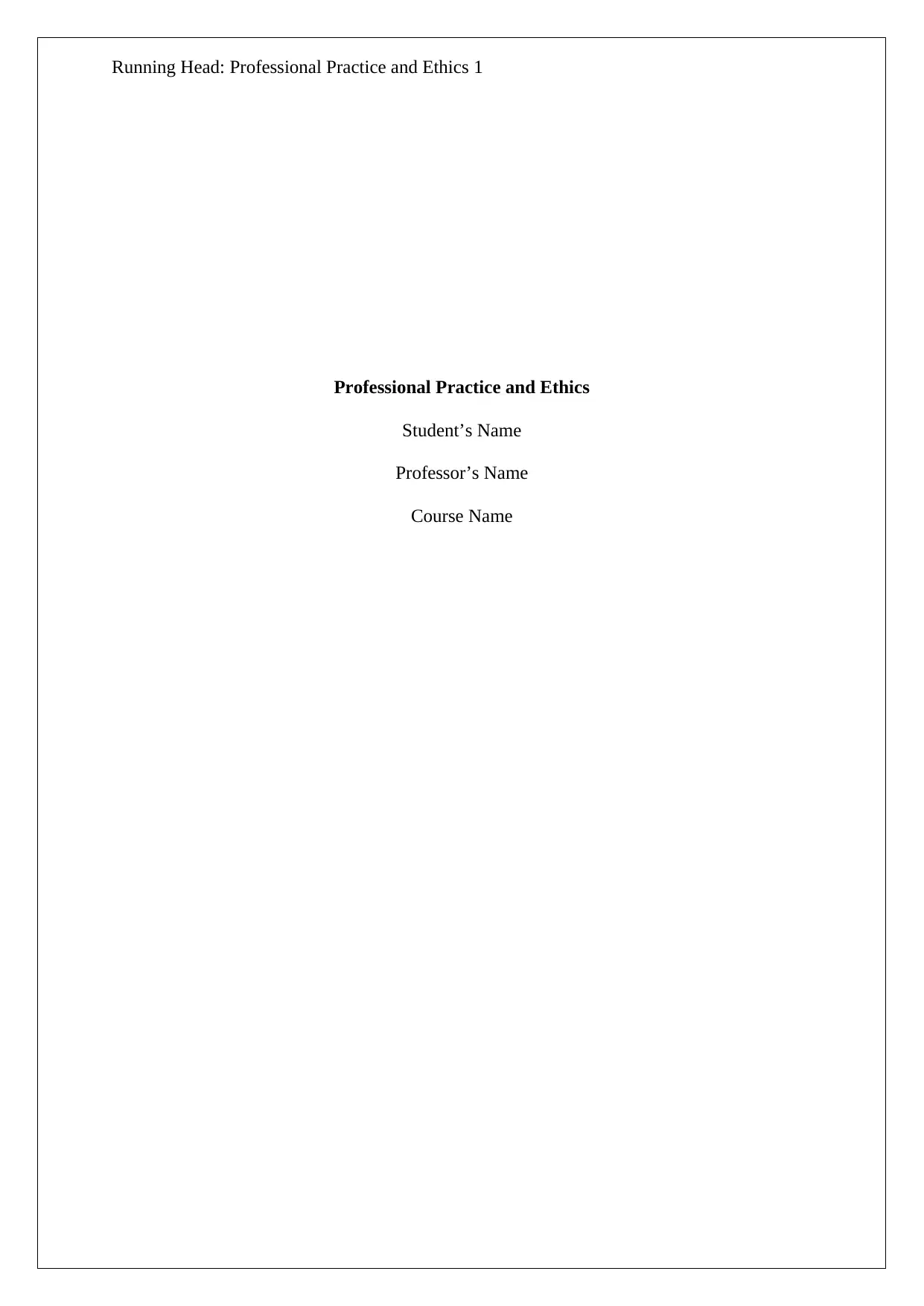
Running Head: Professional Practice and Ethics 1
Professional Practice and Ethics
Student’s Name
Professor’s Name
Course Name
Professional Practice and Ethics
Student’s Name
Professor’s Name
Course Name
Paraphrase This Document
Need a fresh take? Get an instant paraphrase of this document with our AI Paraphraser
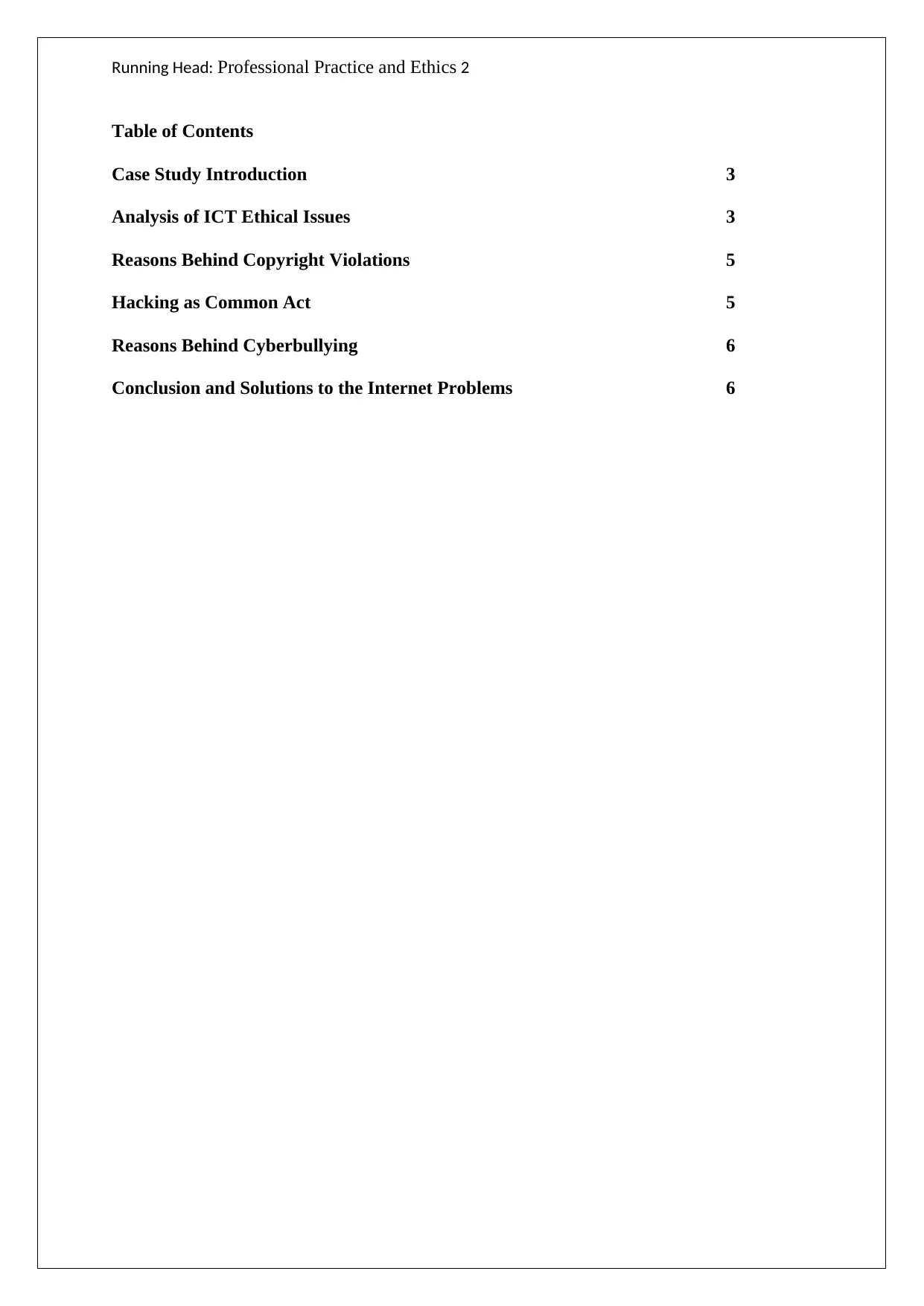
Running Head: Professional Practice and Ethics 2
Table of Contents
Case Study Introduction 3
Analysis of ICT Ethical Issues 3
Reasons Behind Copyright Violations 5
Hacking as Common Act 5
Reasons Behind Cyberbullying 6
Conclusion and Solutions to the Internet Problems 6
Table of Contents
Case Study Introduction 3
Analysis of ICT Ethical Issues 3
Reasons Behind Copyright Violations 5
Hacking as Common Act 5
Reasons Behind Cyberbullying 6
Conclusion and Solutions to the Internet Problems 6
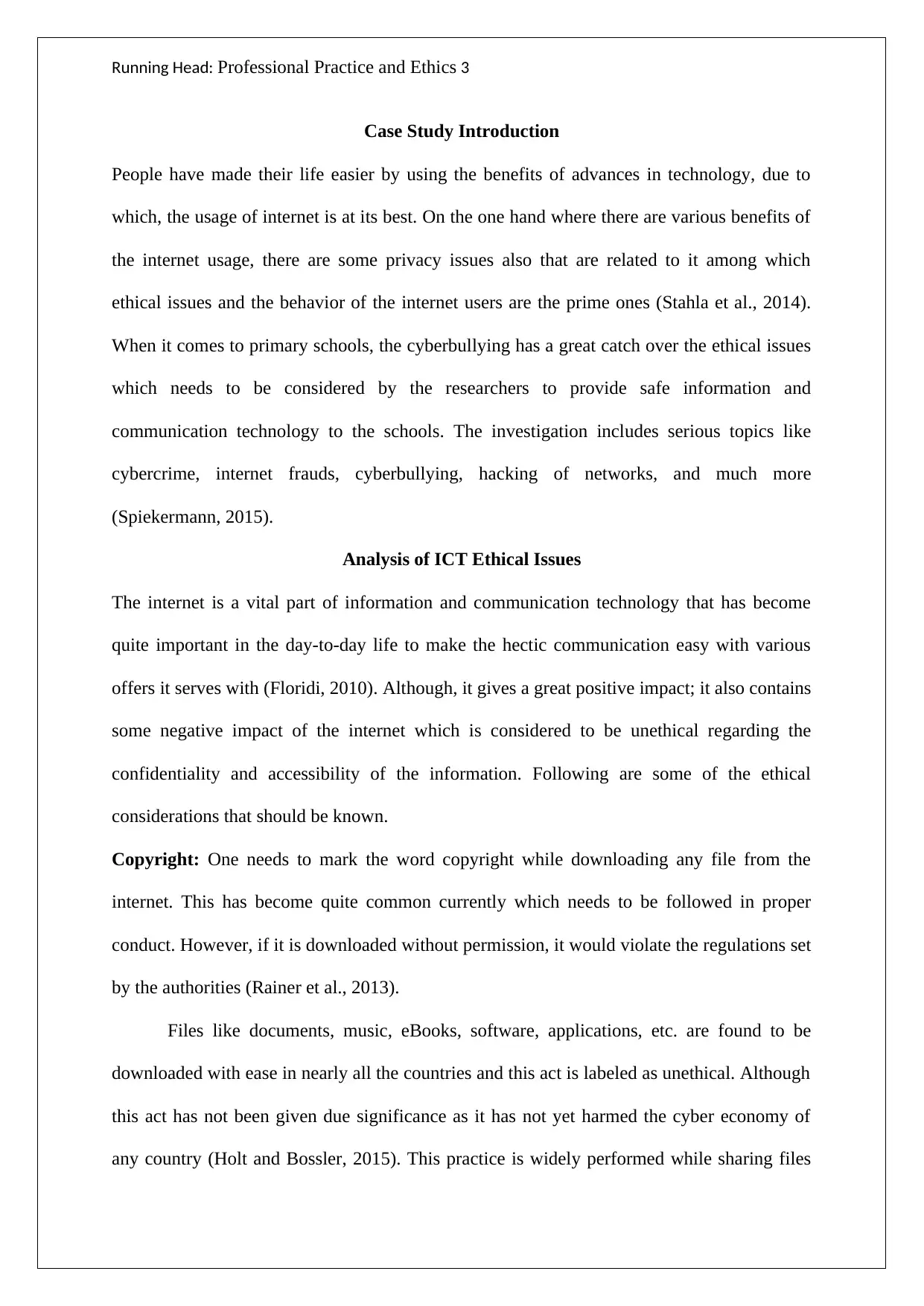
Running Head: Professional Practice and Ethics 3
Case Study Introduction
People have made their life easier by using the benefits of advances in technology, due to
which, the usage of internet is at its best. On the one hand where there are various benefits of
the internet usage, there are some privacy issues also that are related to it among which
ethical issues and the behavior of the internet users are the prime ones (Stahla et al., 2014).
When it comes to primary schools, the cyberbullying has a great catch over the ethical issues
which needs to be considered by the researchers to provide safe information and
communication technology to the schools. The investigation includes serious topics like
cybercrime, internet frauds, cyberbullying, hacking of networks, and much more
(Spiekermann, 2015).
Analysis of ICT Ethical Issues
The internet is a vital part of information and communication technology that has become
quite important in the day-to-day life to make the hectic communication easy with various
offers it serves with (Floridi, 2010). Although, it gives a great positive impact; it also contains
some negative impact of the internet which is considered to be unethical regarding the
confidentiality and accessibility of the information. Following are some of the ethical
considerations that should be known.
Copyright: One needs to mark the word copyright while downloading any file from the
internet. This has become quite common currently which needs to be followed in proper
conduct. However, if it is downloaded without permission, it would violate the regulations set
by the authorities (Rainer et al., 2013).
Files like documents, music, eBooks, software, applications, etc. are found to be
downloaded with ease in nearly all the countries and this act is labeled as unethical. Although
this act has not been given due significance as it has not yet harmed the cyber economy of
any country (Holt and Bossler, 2015). This practice is widely performed while sharing files
Case Study Introduction
People have made their life easier by using the benefits of advances in technology, due to
which, the usage of internet is at its best. On the one hand where there are various benefits of
the internet usage, there are some privacy issues also that are related to it among which
ethical issues and the behavior of the internet users are the prime ones (Stahla et al., 2014).
When it comes to primary schools, the cyberbullying has a great catch over the ethical issues
which needs to be considered by the researchers to provide safe information and
communication technology to the schools. The investigation includes serious topics like
cybercrime, internet frauds, cyberbullying, hacking of networks, and much more
(Spiekermann, 2015).
Analysis of ICT Ethical Issues
The internet is a vital part of information and communication technology that has become
quite important in the day-to-day life to make the hectic communication easy with various
offers it serves with (Floridi, 2010). Although, it gives a great positive impact; it also contains
some negative impact of the internet which is considered to be unethical regarding the
confidentiality and accessibility of the information. Following are some of the ethical
considerations that should be known.
Copyright: One needs to mark the word copyright while downloading any file from the
internet. This has become quite common currently which needs to be followed in proper
conduct. However, if it is downloaded without permission, it would violate the regulations set
by the authorities (Rainer et al., 2013).
Files like documents, music, eBooks, software, applications, etc. are found to be
downloaded with ease in nearly all the countries and this act is labeled as unethical. Although
this act has not been given due significance as it has not yet harmed the cyber economy of
any country (Holt and Bossler, 2015). This practice is widely performed while sharing files
⊘ This is a preview!⊘
Do you want full access?
Subscribe today to unlock all pages.

Trusted by 1+ million students worldwide
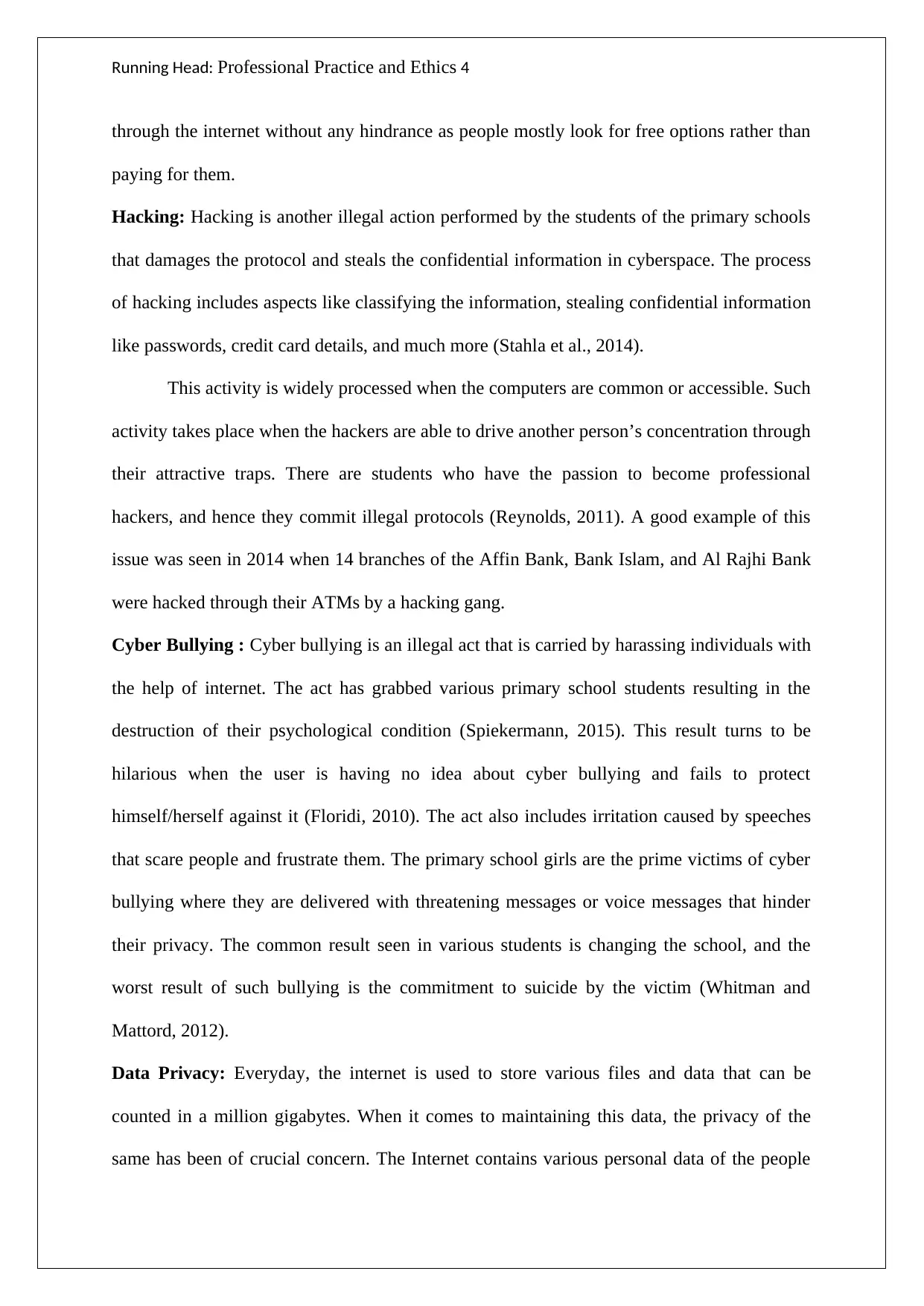
Running Head: Professional Practice and Ethics 4
through the internet without any hindrance as people mostly look for free options rather than
paying for them.
Hacking: Hacking is another illegal action performed by the students of the primary schools
that damages the protocol and steals the confidential information in cyberspace. The process
of hacking includes aspects like classifying the information, stealing confidential information
like passwords, credit card details, and much more (Stahla et al., 2014).
This activity is widely processed when the computers are common or accessible. Such
activity takes place when the hackers are able to drive another person’s concentration through
their attractive traps. There are students who have the passion to become professional
hackers, and hence they commit illegal protocols (Reynolds, 2011). A good example of this
issue was seen in 2014 when 14 branches of the Affin Bank, Bank Islam, and Al Rajhi Bank
were hacked through their ATMs by a hacking gang.
Cyber Bullying : Cyber bullying is an illegal act that is carried by harassing individuals with
the help of internet. The act has grabbed various primary school students resulting in the
destruction of their psychological condition (Spiekermann, 2015). This result turns to be
hilarious when the user is having no idea about cyber bullying and fails to protect
himself/herself against it (Floridi, 2010). The act also includes irritation caused by speeches
that scare people and frustrate them. The primary school girls are the prime victims of cyber
bullying where they are delivered with threatening messages or voice messages that hinder
their privacy. The common result seen in various students is changing the school, and the
worst result of such bullying is the commitment to suicide by the victim (Whitman and
Mattord, 2012).
Data Privacy: Everyday, the internet is used to store various files and data that can be
counted in a million gigabytes. When it comes to maintaining this data, the privacy of the
same has been of crucial concern. The Internet contains various personal data of the people
through the internet without any hindrance as people mostly look for free options rather than
paying for them.
Hacking: Hacking is another illegal action performed by the students of the primary schools
that damages the protocol and steals the confidential information in cyberspace. The process
of hacking includes aspects like classifying the information, stealing confidential information
like passwords, credit card details, and much more (Stahla et al., 2014).
This activity is widely processed when the computers are common or accessible. Such
activity takes place when the hackers are able to drive another person’s concentration through
their attractive traps. There are students who have the passion to become professional
hackers, and hence they commit illegal protocols (Reynolds, 2011). A good example of this
issue was seen in 2014 when 14 branches of the Affin Bank, Bank Islam, and Al Rajhi Bank
were hacked through their ATMs by a hacking gang.
Cyber Bullying : Cyber bullying is an illegal act that is carried by harassing individuals with
the help of internet. The act has grabbed various primary school students resulting in the
destruction of their psychological condition (Spiekermann, 2015). This result turns to be
hilarious when the user is having no idea about cyber bullying and fails to protect
himself/herself against it (Floridi, 2010). The act also includes irritation caused by speeches
that scare people and frustrate them. The primary school girls are the prime victims of cyber
bullying where they are delivered with threatening messages or voice messages that hinder
their privacy. The common result seen in various students is changing the school, and the
worst result of such bullying is the commitment to suicide by the victim (Whitman and
Mattord, 2012).
Data Privacy: Everyday, the internet is used to store various files and data that can be
counted in a million gigabytes. When it comes to maintaining this data, the privacy of the
same has been of crucial concern. The Internet contains various personal data of the people
Paraphrase This Document
Need a fresh take? Get an instant paraphrase of this document with our AI Paraphraser
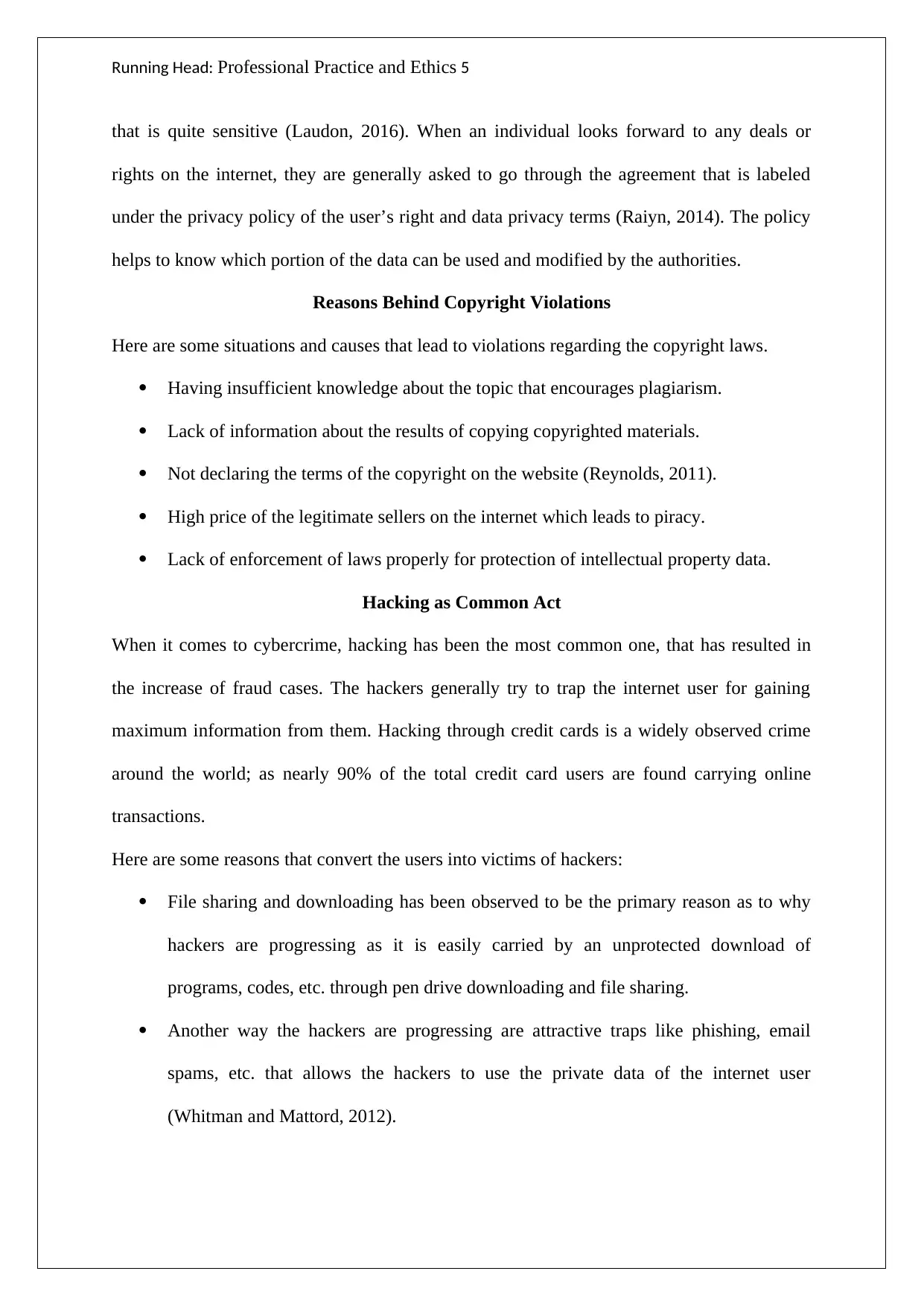
Running Head: Professional Practice and Ethics 5
that is quite sensitive (Laudon, 2016). When an individual looks forward to any deals or
rights on the internet, they are generally asked to go through the agreement that is labeled
under the privacy policy of the user’s right and data privacy terms (Raiyn, 2014). The policy
helps to know which portion of the data can be used and modified by the authorities.
Reasons Behind Copyright Violations
Here are some situations and causes that lead to violations regarding the copyright laws.
Having insufficient knowledge about the topic that encourages plagiarism.
Lack of information about the results of copying copyrighted materials.
Not declaring the terms of the copyright on the website (Reynolds, 2011).
High price of the legitimate sellers on the internet which leads to piracy.
Lack of enforcement of laws properly for protection of intellectual property data.
Hacking as Common Act
When it comes to cybercrime, hacking has been the most common one, that has resulted in
the increase of fraud cases. The hackers generally try to trap the internet user for gaining
maximum information from them. Hacking through credit cards is a widely observed crime
around the world; as nearly 90% of the total credit card users are found carrying online
transactions.
Here are some reasons that convert the users into victims of hackers:
File sharing and downloading has been observed to be the primary reason as to why
hackers are progressing as it is easily carried by an unprotected download of
programs, codes, etc. through pen drive downloading and file sharing.
Another way the hackers are progressing are attractive traps like phishing, email
spams, etc. that allows the hackers to use the private data of the internet user
(Whitman and Mattord, 2012).
that is quite sensitive (Laudon, 2016). When an individual looks forward to any deals or
rights on the internet, they are generally asked to go through the agreement that is labeled
under the privacy policy of the user’s right and data privacy terms (Raiyn, 2014). The policy
helps to know which portion of the data can be used and modified by the authorities.
Reasons Behind Copyright Violations
Here are some situations and causes that lead to violations regarding the copyright laws.
Having insufficient knowledge about the topic that encourages plagiarism.
Lack of information about the results of copying copyrighted materials.
Not declaring the terms of the copyright on the website (Reynolds, 2011).
High price of the legitimate sellers on the internet which leads to piracy.
Lack of enforcement of laws properly for protection of intellectual property data.
Hacking as Common Act
When it comes to cybercrime, hacking has been the most common one, that has resulted in
the increase of fraud cases. The hackers generally try to trap the internet user for gaining
maximum information from them. Hacking through credit cards is a widely observed crime
around the world; as nearly 90% of the total credit card users are found carrying online
transactions.
Here are some reasons that convert the users into victims of hackers:
File sharing and downloading has been observed to be the primary reason as to why
hackers are progressing as it is easily carried by an unprotected download of
programs, codes, etc. through pen drive downloading and file sharing.
Another way the hackers are progressing are attractive traps like phishing, email
spams, etc. that allows the hackers to use the private data of the internet user
(Whitman and Mattord, 2012).
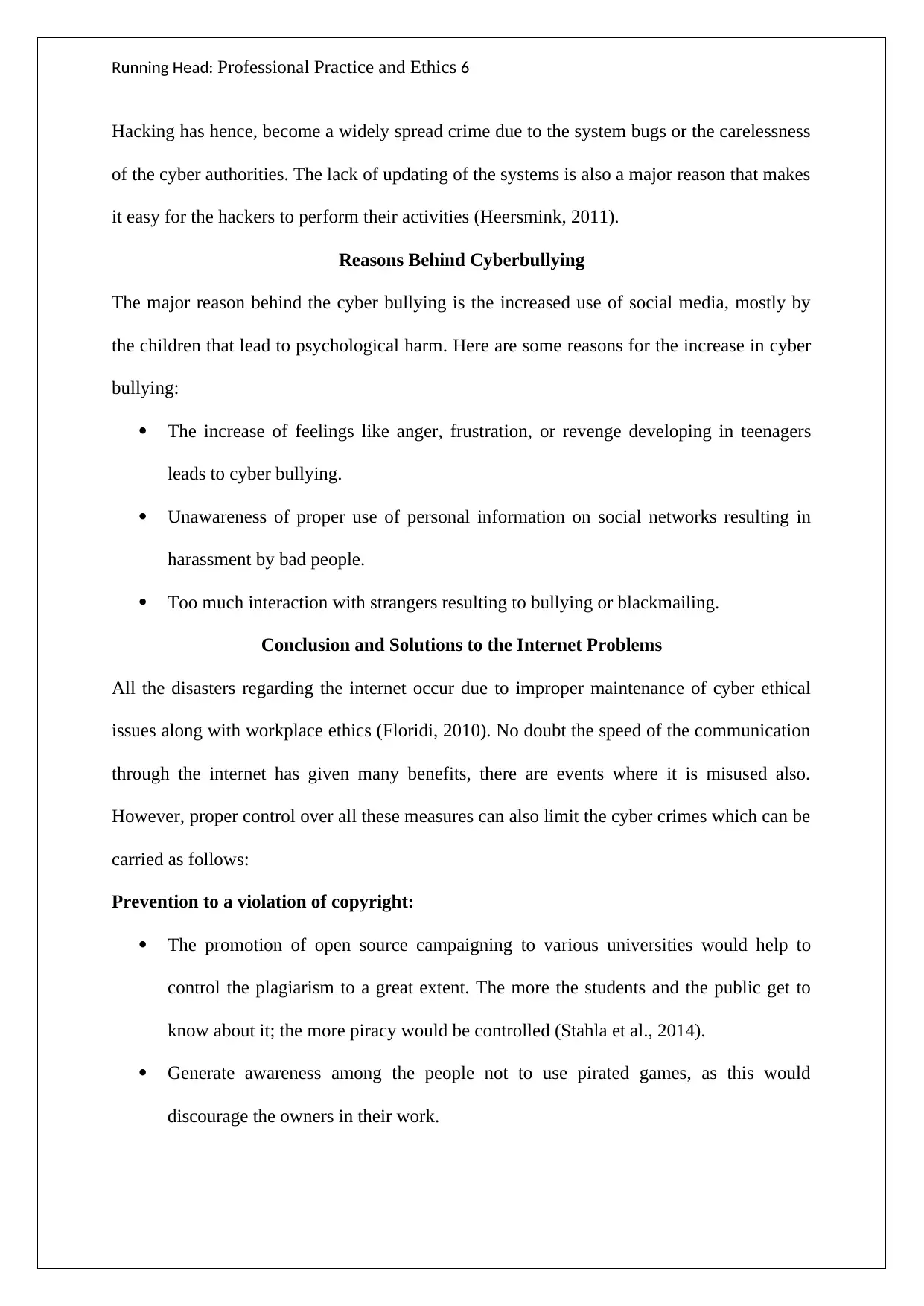
Running Head: Professional Practice and Ethics 6
Hacking has hence, become a widely spread crime due to the system bugs or the carelessness
of the cyber authorities. The lack of updating of the systems is also a major reason that makes
it easy for the hackers to perform their activities (Heersmink, 2011).
Reasons Behind Cyberbullying
The major reason behind the cyber bullying is the increased use of social media, mostly by
the children that lead to psychological harm. Here are some reasons for the increase in cyber
bullying:
The increase of feelings like anger, frustration, or revenge developing in teenagers
leads to cyber bullying.
Unawareness of proper use of personal information on social networks resulting in
harassment by bad people.
Too much interaction with strangers resulting to bullying or blackmailing.
Conclusion and Solutions to the Internet Problems
All the disasters regarding the internet occur due to improper maintenance of cyber ethical
issues along with workplace ethics (Floridi, 2010). No doubt the speed of the communication
through the internet has given many benefits, there are events where it is misused also.
However, proper control over all these measures can also limit the cyber crimes which can be
carried as follows:
Prevention to a violation of copyright:
The promotion of open source campaigning to various universities would help to
control the plagiarism to a great extent. The more the students and the public get to
know about it; the more piracy would be controlled (Stahla et al., 2014).
Generate awareness among the people not to use pirated games, as this would
discourage the owners in their work.
Hacking has hence, become a widely spread crime due to the system bugs or the carelessness
of the cyber authorities. The lack of updating of the systems is also a major reason that makes
it easy for the hackers to perform their activities (Heersmink, 2011).
Reasons Behind Cyberbullying
The major reason behind the cyber bullying is the increased use of social media, mostly by
the children that lead to psychological harm. Here are some reasons for the increase in cyber
bullying:
The increase of feelings like anger, frustration, or revenge developing in teenagers
leads to cyber bullying.
Unawareness of proper use of personal information on social networks resulting in
harassment by bad people.
Too much interaction with strangers resulting to bullying or blackmailing.
Conclusion and Solutions to the Internet Problems
All the disasters regarding the internet occur due to improper maintenance of cyber ethical
issues along with workplace ethics (Floridi, 2010). No doubt the speed of the communication
through the internet has given many benefits, there are events where it is misused also.
However, proper control over all these measures can also limit the cyber crimes which can be
carried as follows:
Prevention to a violation of copyright:
The promotion of open source campaigning to various universities would help to
control the plagiarism to a great extent. The more the students and the public get to
know about it; the more piracy would be controlled (Stahla et al., 2014).
Generate awareness among the people not to use pirated games, as this would
discourage the owners in their work.
⊘ This is a preview!⊘
Do you want full access?
Subscribe today to unlock all pages.

Trusted by 1+ million students worldwide
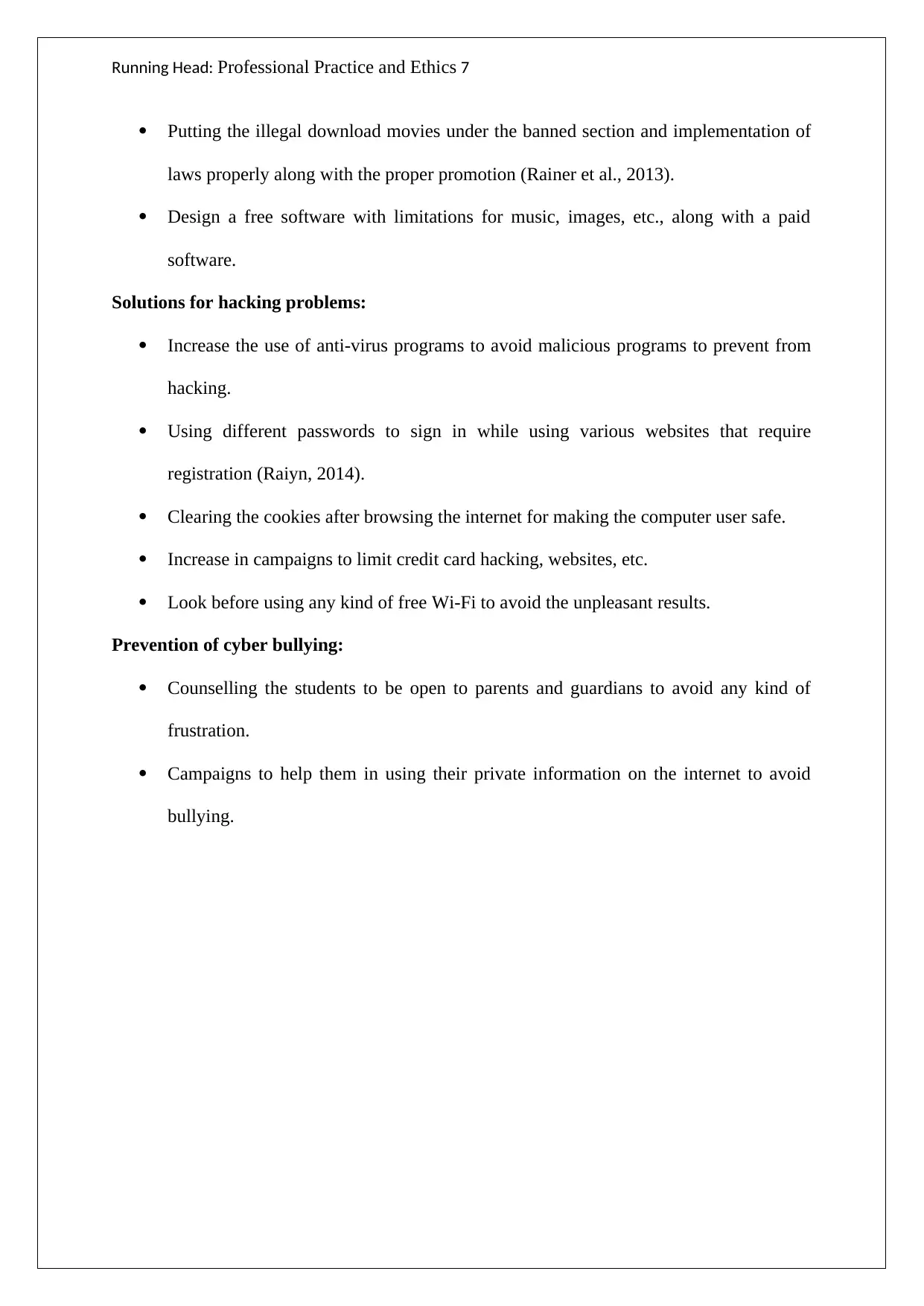
Running Head: Professional Practice and Ethics 7
Putting the illegal download movies under the banned section and implementation of
laws properly along with the proper promotion (Rainer et al., 2013).
Design a free software with limitations for music, images, etc., along with a paid
software.
Solutions for hacking problems:
Increase the use of anti-virus programs to avoid malicious programs to prevent from
hacking.
Using different passwords to sign in while using various websites that require
registration (Raiyn, 2014).
Clearing the cookies after browsing the internet for making the computer user safe.
Increase in campaigns to limit credit card hacking, websites, etc.
Look before using any kind of free Wi-Fi to avoid the unpleasant results.
Prevention of cyber bullying:
Counselling the students to be open to parents and guardians to avoid any kind of
frustration.
Campaigns to help them in using their private information on the internet to avoid
bullying.
Putting the illegal download movies under the banned section and implementation of
laws properly along with the proper promotion (Rainer et al., 2013).
Design a free software with limitations for music, images, etc., along with a paid
software.
Solutions for hacking problems:
Increase the use of anti-virus programs to avoid malicious programs to prevent from
hacking.
Using different passwords to sign in while using various websites that require
registration (Raiyn, 2014).
Clearing the cookies after browsing the internet for making the computer user safe.
Increase in campaigns to limit credit card hacking, websites, etc.
Look before using any kind of free Wi-Fi to avoid the unpleasant results.
Prevention of cyber bullying:
Counselling the students to be open to parents and guardians to avoid any kind of
frustration.
Campaigns to help them in using their private information on the internet to avoid
bullying.
Paraphrase This Document
Need a fresh take? Get an instant paraphrase of this document with our AI Paraphraser
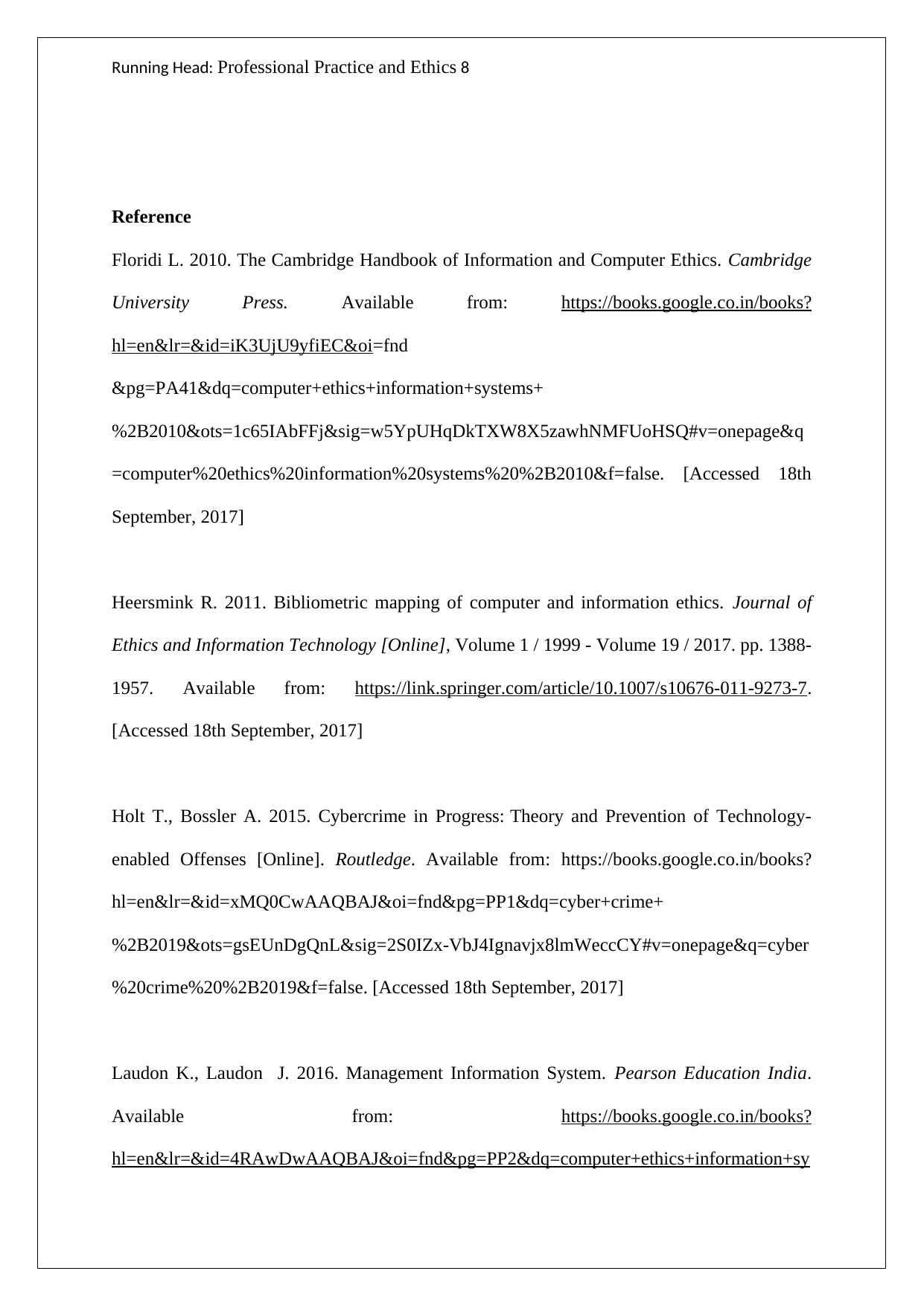
Running Head: Professional Practice and Ethics 8
Reference
Floridi L. 2010. The Cambridge Handbook of Information and Computer Ethics. Cambridge
University Press. Available from: https://books.google.co.in/books?
hl=en&lr=&id=iK3UjU9yfiEC&oi=fnd
&pg=PA41&dq=computer+ethics+information+systems+
%2B2010&ots=1c65IAbFFj&sig=w5YpUHqDkTXW8X5zawhNMFUoHSQ#v=onepage&q
=computer%20ethics%20information%20systems%20%2B2010&f=false. [Accessed 18th
September, 2017]
Heersmink R. 2011. Bibliometric mapping of computer and information ethics. Journal of
Ethics and Information Technology [Online], Volume 1 / 1999 - Volume 19 / 2017. pp. 1388-
1957. Available from: https://link.springer.com/article/10.1007/s10676-011-9273-7.
[Accessed 18th September, 2017]
Holt T., Bossler A. 2015. Cybercrime in Progress: Theory and Prevention of Technology-
enabled Offenses [Online]. Routledge. Available from: https://books.google.co.in/books?
hl=en&lr=&id=xMQ0CwAAQBAJ&oi=fnd&pg=PP1&dq=cyber+crime+
%2B2019&ots=gsEUnDgQnL&sig=2S0IZx-VbJ4Ignavjx8lmWeccCY#v=onepage&q=cyber
%20crime%20%2B2019&f=false. [Accessed 18th September, 2017]
Laudon K., Laudon J. 2016. Management Information System. Pearson Education India.
Available from: https://books.google.co.in/books?
hl=en&lr=&id=4RAwDwAAQBAJ&oi=fnd&pg=PP2&dq=computer+ethics+information+sy
Reference
Floridi L. 2010. The Cambridge Handbook of Information and Computer Ethics. Cambridge
University Press. Available from: https://books.google.co.in/books?
hl=en&lr=&id=iK3UjU9yfiEC&oi=fnd
&pg=PA41&dq=computer+ethics+information+systems+
%2B2010&ots=1c65IAbFFj&sig=w5YpUHqDkTXW8X5zawhNMFUoHSQ#v=onepage&q
=computer%20ethics%20information%20systems%20%2B2010&f=false. [Accessed 18th
September, 2017]
Heersmink R. 2011. Bibliometric mapping of computer and information ethics. Journal of
Ethics and Information Technology [Online], Volume 1 / 1999 - Volume 19 / 2017. pp. 1388-
1957. Available from: https://link.springer.com/article/10.1007/s10676-011-9273-7.
[Accessed 18th September, 2017]
Holt T., Bossler A. 2015. Cybercrime in Progress: Theory and Prevention of Technology-
enabled Offenses [Online]. Routledge. Available from: https://books.google.co.in/books?
hl=en&lr=&id=xMQ0CwAAQBAJ&oi=fnd&pg=PP1&dq=cyber+crime+
%2B2019&ots=gsEUnDgQnL&sig=2S0IZx-VbJ4Ignavjx8lmWeccCY#v=onepage&q=cyber
%20crime%20%2B2019&f=false. [Accessed 18th September, 2017]
Laudon K., Laudon J. 2016. Management Information System. Pearson Education India.
Available from: https://books.google.co.in/books?
hl=en&lr=&id=4RAwDwAAQBAJ&oi=fnd&pg=PP2&dq=computer+ethics+information+sy
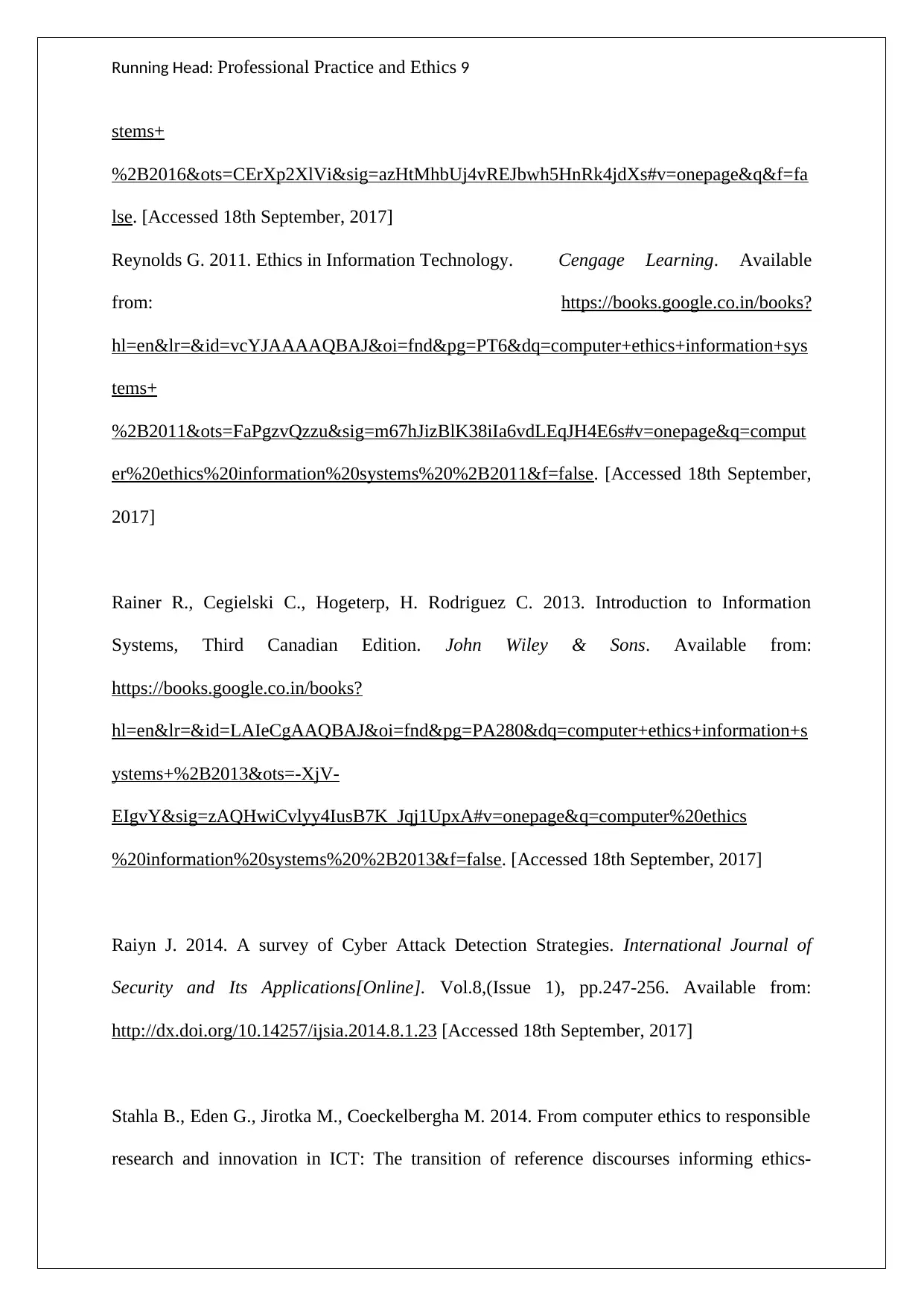
Running Head: Professional Practice and Ethics 9
stems+
%2B2016&ots=CErXp2XlVi&sig=azHtMhbUj4vREJbwh5HnRk4jdXs#v=onepage&q&f=fa
lse. [Accessed 18th September, 2017]
Reynolds G. 2011. Ethics in Information Technology. Cengage Learning. Available
from: https://books.google.co.in/books?
hl=en&lr=&id=vcYJAAAAQBAJ&oi=fnd&pg=PT6&dq=computer+ethics+information+sys
tems+
%2B2011&ots=FaPgzvQzzu&sig=m67hJizBlK38iIa6vdLEqJH4E6s#v=onepage&q=comput
er%20ethics%20information%20systems%20%2B2011&f=false. [Accessed 18th September,
2017]
Rainer R., Cegielski C., Hogeterp, H. Rodriguez C. 2013. Introduction to Information
Systems, Third Canadian Edition. John Wiley & Sons. Available from:
https://books.google.co.in/books?
hl=en&lr=&id=LAIeCgAAQBAJ&oi=fnd&pg=PA280&dq=computer+ethics+information+s
ystems+%2B2013&ots=-XjV-
EIgvY&sig=zAQHwiCvlyy4IusB7K_Jqj1UpxA#v=onepage&q=computer%20ethics
%20information%20systems%20%2B2013&f=false. [Accessed 18th September, 2017]
Raiyn J. 2014. A survey of Cyber Attack Detection Strategies. International Journal of
Security and Its Applications[Online]. Vol.8,(Issue 1), pp.247-256. Available from:
http://dx.doi.org/10.14257/ijsia.2014.8.1.23 [Accessed 18th September, 2017]
Stahla B., Eden G., Jirotka M., Coeckelbergha M. 2014. From computer ethics to responsible
research and innovation in ICT: The transition of reference discourses informing ethics-
stems+
%2B2016&ots=CErXp2XlVi&sig=azHtMhbUj4vREJbwh5HnRk4jdXs#v=onepage&q&f=fa
lse. [Accessed 18th September, 2017]
Reynolds G. 2011. Ethics in Information Technology. Cengage Learning. Available
from: https://books.google.co.in/books?
hl=en&lr=&id=vcYJAAAAQBAJ&oi=fnd&pg=PT6&dq=computer+ethics+information+sys
tems+
%2B2011&ots=FaPgzvQzzu&sig=m67hJizBlK38iIa6vdLEqJH4E6s#v=onepage&q=comput
er%20ethics%20information%20systems%20%2B2011&f=false. [Accessed 18th September,
2017]
Rainer R., Cegielski C., Hogeterp, H. Rodriguez C. 2013. Introduction to Information
Systems, Third Canadian Edition. John Wiley & Sons. Available from:
https://books.google.co.in/books?
hl=en&lr=&id=LAIeCgAAQBAJ&oi=fnd&pg=PA280&dq=computer+ethics+information+s
ystems+%2B2013&ots=-XjV-
EIgvY&sig=zAQHwiCvlyy4IusB7K_Jqj1UpxA#v=onepage&q=computer%20ethics
%20information%20systems%20%2B2013&f=false. [Accessed 18th September, 2017]
Raiyn J. 2014. A survey of Cyber Attack Detection Strategies. International Journal of
Security and Its Applications[Online]. Vol.8,(Issue 1), pp.247-256. Available from:
http://dx.doi.org/10.14257/ijsia.2014.8.1.23 [Accessed 18th September, 2017]
Stahla B., Eden G., Jirotka M., Coeckelbergha M. 2014. From computer ethics to responsible
research and innovation in ICT: The transition of reference discourses informing ethics-
⊘ This is a preview!⊘
Do you want full access?
Subscribe today to unlock all pages.

Trusted by 1+ million students worldwide
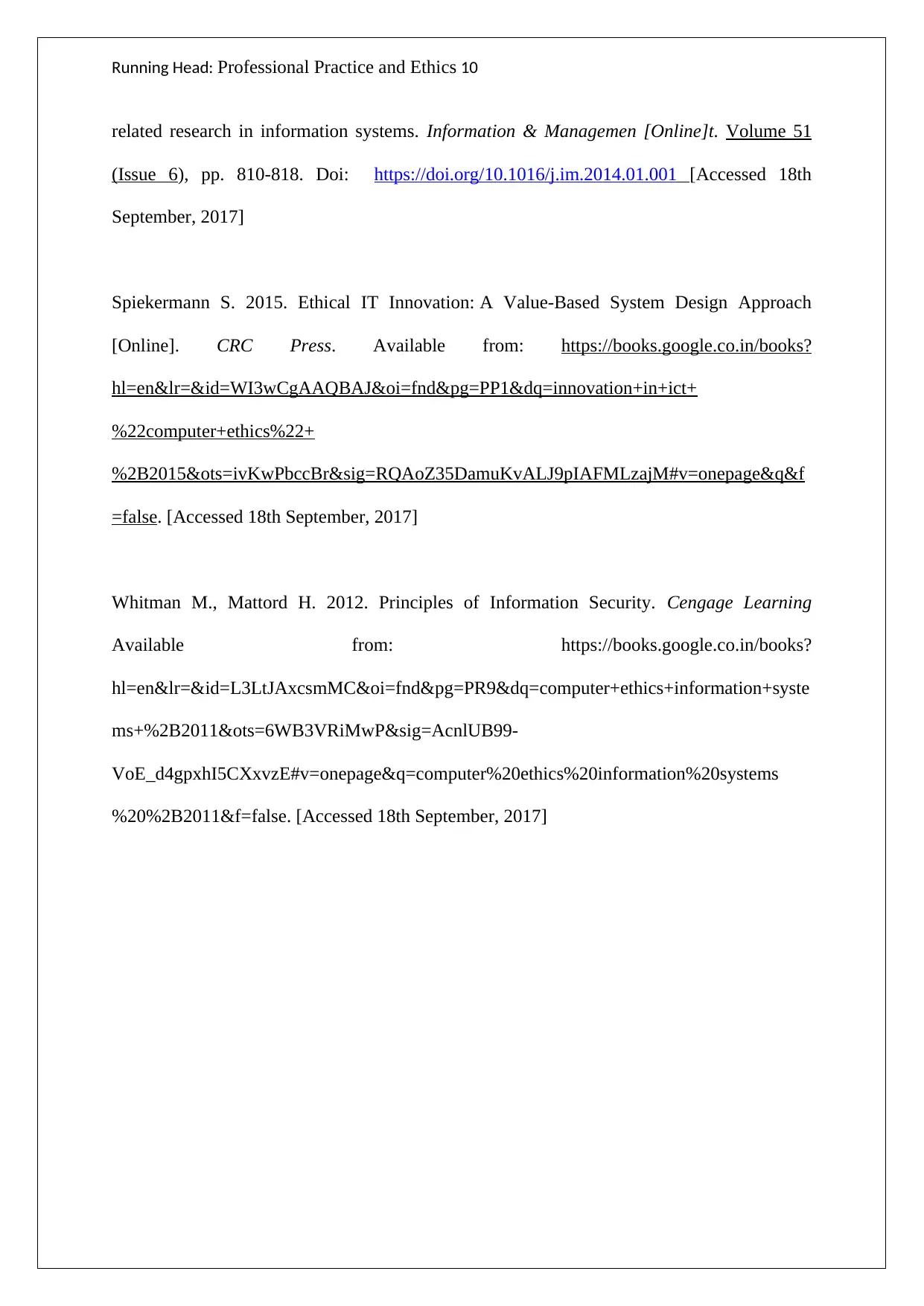
Running Head: Professional Practice and Ethics 10
related research in information systems. Information & Managemen [Online]t. Volume 51
(Issue 6), pp. 810-818. Doi: https://doi.org/10.1016/j.im.2014.01.001 [Accessed 18th
September, 2017]
Spiekermann S. 2015. Ethical IT Innovation: A Value-Based System Design Approach
[Online]. CRC Press. Available from: https://books.google.co.in/books?
hl=en&lr=&id=WI3wCgAAQBAJ&oi=fnd&pg=PP1&dq=innovation+in+ict+
%22computer+ethics%22+
%2B2015&ots=ivKwPbccBr&sig=RQAoZ35DamuKvALJ9pIAFMLzajM#v=onepage&q&f
=false. [Accessed 18th September, 2017]
Whitman M., Mattord H. 2012. Principles of Information Security. Cengage Learning
Available from: https://books.google.co.in/books?
hl=en&lr=&id=L3LtJAxcsmMC&oi=fnd&pg=PR9&dq=computer+ethics+information+syste
ms+%2B2011&ots=6WB3VRiMwP&sig=AcnlUB99-
VoE_d4gpxhI5CXxvzE#v=onepage&q=computer%20ethics%20information%20systems
%20%2B2011&f=false. [Accessed 18th September, 2017]
related research in information systems. Information & Managemen [Online]t. Volume 51
(Issue 6), pp. 810-818. Doi: https://doi.org/10.1016/j.im.2014.01.001 [Accessed 18th
September, 2017]
Spiekermann S. 2015. Ethical IT Innovation: A Value-Based System Design Approach
[Online]. CRC Press. Available from: https://books.google.co.in/books?
hl=en&lr=&id=WI3wCgAAQBAJ&oi=fnd&pg=PP1&dq=innovation+in+ict+
%22computer+ethics%22+
%2B2015&ots=ivKwPbccBr&sig=RQAoZ35DamuKvALJ9pIAFMLzajM#v=onepage&q&f
=false. [Accessed 18th September, 2017]
Whitman M., Mattord H. 2012. Principles of Information Security. Cengage Learning
Available from: https://books.google.co.in/books?
hl=en&lr=&id=L3LtJAxcsmMC&oi=fnd&pg=PR9&dq=computer+ethics+information+syste
ms+%2B2011&ots=6WB3VRiMwP&sig=AcnlUB99-
VoE_d4gpxhI5CXxvzE#v=onepage&q=computer%20ethics%20information%20systems
%20%2B2011&f=false. [Accessed 18th September, 2017]
1 out of 10
Related Documents
Your All-in-One AI-Powered Toolkit for Academic Success.
+13062052269
info@desklib.com
Available 24*7 on WhatsApp / Email
![[object Object]](/_next/static/media/star-bottom.7253800d.svg)
Unlock your academic potential
Copyright © 2020–2025 A2Z Services. All Rights Reserved. Developed and managed by ZUCOL.





